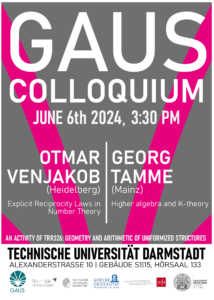15:30 Georg Tamme (Universität Mainz): Higher algebra and K-theory Algebraic K-theory, more precisely the group K_0(X) of a scheme X, was first introduced by Grothendieck in order to formulate and prove a very general Riemann-Roch theorem. Subsequently, lower (i.e. K_i for i<0) and higher (i.e. K_i for i>0) K-groups have been introduced by Bass, Milnor, Quillen, and Thomason. They have turned out to be a rich invariant, playing an important role in various fields such as number theory and topology. Although explicit computations of K-groups remain challenging, modern methods from higher algebra and derived algebraic geometry have led to several breakthrough structural results concerning these groups. In the talk, I will give an introduction to these topics and, time permitting, discuss some recent applications. |  |
| 17:15 Otmar Venjakob (Universität Heidelberg): Explicit Reciprocity Laws in Number TheoryThe quadratic Reciprocity Law for the Legendre or Jacobi-Symbol forms the starting point of all Reciprocity Laws as well as of class field theory. It is closely related to the product formula of the quadratic Hilbert-Symbol over local fields. Various mathematicians have established higher explicit formulae to compute higher Hilbert-Symbols. Analogs were found for formal (Lubin-Tate) groups. Eventually Perrin-Riou has formulated a Reciprocity Law, which allows the explicit computation of local cup product pairings by means of Iwasawa- and p-adic Hodge Theory. In this talk I shall try to give an overview of these topics, at the end I will explain recent developments in this regard. |
15:30 Ben Heuer (Universität Frankfurt): p-adic non-abelian Hodge theory for non-p-adic mathematicians In p-adic non-abelian Hodge theory, we study p-adic representations of fundamental groups of projective varieties. This talk will give an introduction to this subject without assuming any background in p-adic geometry. Based on examples, I will explain the “p-adic Simpson correspondence”, with an emphasis on the relation to complex geometry. I will discuss recent advances, the main open questions in the area, and potential applications to complex geometry. |  |
17:00 Jan Brunier (Universität Darmstadt): Theta functions in geometry and arithmetic We explain how theta functions can be used to study positive definite quadratic forms and their representation numbers. For indefinite quadratic forms, Kudla and Millson showed that there are analogous theta functions relating the geometry of special cycles on locally symmetric spaces to modular forms. Conjectures of Kudla predict similar results for arithmetic special cycles in Arakelov Chow groups on integral models of orthogonal Shimura varieties. We will also report on some recent results in this context. |
Jacob Tsimerman (University of Toronto): Heights on arbitrary Shimura Varieties and Tori
We explain how to prove upper bounds for heights of special points on arbitrary Shimura Varieties, completing the proof after the work of Binyamini-Schmidt-Yafaev. The proof in fact reduces to the case of A_g, and thus requires a comparison of height functions between distinct Shimura varieties. To facilitate this, we introduce a canonical height function corresponding to automorphic vector bundles on it and explain their functorial properties. This is achieved using relative p-adic Hodge theory, combining the de-Rham and crystalline formalisms. This also reduces the question of bounding these canonical heights in 0-dimensional settings. Finally, we explain how a trick of Deligne allows us to conclude this case using functoriality and the Abelian case.
June Huh (Princeton University): Kazhdan-Lusztig theory of matroids and its relation to Hodge theory
There is a remarkable parallel between the theory of Coxeter groups (think of the symmetric group or the dihedral group) and matroids (think of your favorite graph or vector configuration). After giving an overview of the similarity, I will report proofs of two combinatorial conjectures, the nonnegativity conjecture for Kazhdan-Lusztig coefficients and the top-heavy conjecture for the number of flats of matroids. The key step is to formulate and prove an analogue of the decomposition theorem for a resolution of singularities in a combinatorial setup, which is closely related to the validity of the hard Lefschetz theorem and the Hodge-Riemann relations for what would be an intersection Chow cohomology in realizable cases. The talk should be enjoyable without specialized knowledge. Joint work with Tom Braden, Jacob Matherne, Nick Proudfoot, and Botong Wang.